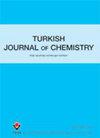光动力治疗用水溶性酞菁光敏剂
IF 1.3
4区 化学
Q3 CHEMISTRY, MULTIDISCIPLINARY
引用次数: 0
摘要
光动力疗法(PDT)基于光化学反应,当光激活光敏过程并导致肿瘤细胞死亡时,该反应就开始了。在PDT应用中,为了研究酞菁的物理和化学特性,溶解度是至关重要的,但不幸的是,大多数酞菁的溶解度有限,尤其是在水中。为了提高酞菁在极性溶剂和水中的溶解度,经常将- so3 -、- nr3 +、- coo -等离子基团和聚氧链等非离子基团添加到酞菁框架的外周或非外周位置。由于水溶性和nir吸收性能是有效的PDT活化的必要条件,研究一直集中在这些类型的酞菁衍生物的合成上。本文综述了近五年来新发表的离子和非离子酞菁介导的光敏剂的光物理、光化学和一些体外或体内研究。本文的综述将对今后酞菁化学及其PDT应用、光化学的研究有积极的贡献本文章由计算机程序翻译,如有差异,请以英文原文为准。
Water-soluble phthalocyanine photosensitizers for photodynamic therapy
Photodynamic therapy (PDT) is based on a photochemical reaction that is started when a photosensitizing process is activated by the light and results in the death of tumor cells. Solubility is crucial in PDT applications to investigate the physical and chemical characteristics of phthalocyanines, but, unfortunately, most phthalocyanines show limited solubility especially in water. To increase the solubility of phthalocyanines in polar solvents and water, ionic groups such as -SO3 - , -NR3 +, -COO- , and nonionic groups such as poly-oxy chains are frequently added to the peripheral or nonperipheral positions of the phthalocyanine framework. Since water-solubility and NIR-absorbing properties are essential for efficient PDT activation, studies have been focused on the synthesis of these types of phthalocyanine derivatives. This review focuses on the photophysical, photochemical, and some in vitro or in vivo studies of the recently published ionic and nonionic phthalocyanine-mediated photosensitizers carried out in the last five years. This review will have positive contributions to future studies on phthalocyanine chemistry and their PDT applications as well as photochemistry
求助全文
通过发布文献求助,成功后即可免费获取论文全文。
去求助
来源期刊

Turkish Journal of Chemistry
化学-工程:化工
CiteScore
2.40
自引率
7.10%
发文量
87
审稿时长
3 months
期刊介绍:
The Turkish Journal of Chemistry is a bimonthly multidisciplinary journal published by the Scientific and Technological Research Council of Turkey (TÜBİTAK).
The journal is dedicated to dissemination of knowledge in all disciplines of chemistry (organic, inorganic, physical, polymeric, technical, theoretical and analytical chemistry) as well as research at the interface with other sciences especially in chemical engineering where molecular aspects are key to the findings.
The journal accepts English-language original manuscripts and contribution is open to researchers of all nationalities.
The journal publishes refereed original papers, reviews, letters to editor and issues devoted to special fields.
All manuscripts are peer-reviewed and electronic processing ensures accurate reproduction of text and data, plus publication times as short as possible.
 求助内容:
求助内容: 应助结果提醒方式:
应助结果提醒方式:


